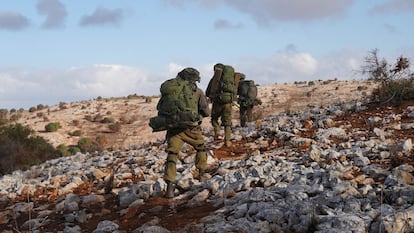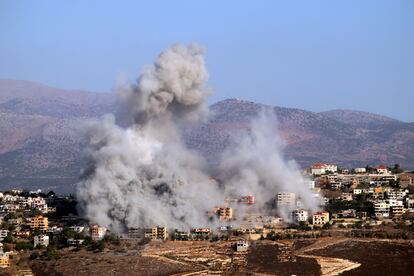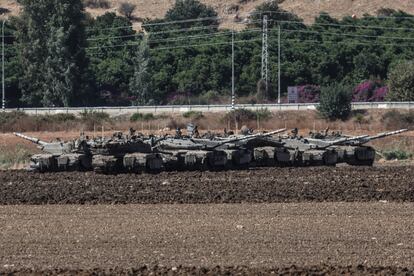Israel’s invasion of Lebanon raises more questions than certainties
In the shadow of the long and bloody military occupation of Gaza, the presence of Israeli troops sparks doubts about the duration, intensity, and result of the operation across its northern border

Israel’s offensive on Lebanon opens a new phase in the war that began in Gaza a year ago on October 7. The ground military invasion launched in southern Lebanon widens the fronts and regional implications of a conflict that until now has been focused on the Gaza Strip. The confrontation with Lebanon raises more questions than certainties about the operation the Israeli army launched Monday, when troops crossed the border into its northern neighbor, and which has so far resulted in nine deaths among Israel Defense Forces (IDF) personnel. The Gaza precedent itself — and that of Ukraine — are two current examples of conflicts with no clear way out, a scenario that may be aggravated in the case of Lebanon.
How long the Israeli operation will last is an open question but there are others to be answered, such as how much Lebanese territory will be invaded, or with what firepower the IDF will be able to operate after almost 12 months of fighting. There are also doubts over whether Israel will succeed in eliminating Hezbollah’s resistance in southern Lebanon, especially the Radwan Force, the militia’s special operations corps. Or whether the evacuees from northern Israel will be able to return home, a primary objective that Israeli Prime Minister Benjamin Netanyahu has set himself. Above all, the conflict could result in a significant number of victims on both sides. The only partially cleared up question so far has been Iran’s response, which came Tuesday with the launch of 180 missiles towards Israel in the biggest attack ever launched by Tehran against the Jewish state, which caused one death, that of a Palestinian in the occupied West Bank.

The Israeli army, which continues to strengthen its presence on the border and on Lebanese soil, has announced that it is carrying out “limited, localized and targeted ground raids.” Although these skirmishes to test the terrain are in some ways reminiscent of the Israeli strategy launched in Gaza at the end of October 2023, the size of Lebanon, despite being a small country, is not comparable (the Gaza Strip covers barely 140 square miles). Nor is the enormous military power of Hezbollah, despite the severe blows suffered in recent days, on a par with the more limited weapons and resources of Hamas and the Palestinian resistance. Hezbollah claims to be fighting the Israeli military in close combat and continues to launch dozens of missiles daily towards their southern neighbor. Meanwhile, the Israeli Air Force is active not only in the south, but also over the capital, Beirut.
The challenge is enormous. Israel “must under no circumstances underestimate the capabilities and means that Hezbollah still has,” warns military analyst Yossi Yehoshua in the daily Yediot Ahronot. The current invasion “will pose a dramatic challenge for the ground forces, which will face a well-trained military force on its territory,” he adds, convinced that the recent setbacks will not prevent the militia from reorganizing its cadre of commanders and its decision-making structure. “This is not going to be a walk in the park. Soldiers who step on that cursed ground are likely to encounter roadside bombs, booby-trapped cars, and anti-tank missile fire. There is also no doubt that Israel will pay a painful price,” Yehoshua predicts.
Israel, meanwhile, will try to make the incursion “clear, crisp and very brief,” says Kobi Michael, an Israeli analyst with the Institute for National Security Studies (INSS) and the Misgav Institute. But he also has his doubts: “I can’t say for sure if it will end up being a long-term thing, although I don’t think that’s what Israel intends to do,” he adds by phone. He believes that Israel has been pushed into a ground invasion because neither the Lebanese government, nor Hezbollah nor the U.N. international peacekeeping force in the area, are able to enforce Resolution 1701, which has prohibited the militia from operating in the border area since 2006. As “others cannot be trusted to do that job, Israel will do whatever is necessary” in Lebanon, Michael concludes.
Israel has previously waged two wars against Lebanon. The first began with the invasion of 1982, coinciding with the birth of Hezbollah, and lasted until 1990, although the Israeli military did not withdraw until a decade later, in 2000. The second conflict, and the last Israeli invasion of Lebanon, which lasted for a month in the summer of 2006, is still very much in the minds of the population today. It is especially remembered by those who live in the north, or among the 60,000 inhabitants who have been displaced from the towns closest to the border and whose return has become a priority for the government.
Israel has no intention of remaining on Lebanese soil for a long time, believes Michael, but it does intend to strike at “strategic” and “crucial” points based on intelligence information in order to try to eliminate the Hezbollah threat and ensure the safe return of its evacuated population. “We must manage to clear that area,” says the security specialist, referring to the strip of land surrounding the border between the two countries. But if the Israeli government ultimately decides that it is necessary for the troops to stay, the expert understands that this will be done in a limited way until an alternative authority to the Israeli army is found.

Israel has insisted that the 18 years since 2006 have served to strengthen Hezbollah and turn it into a significant power, with tens of thousands of fighters, surpassing the strength of the regular Lebanese army. Hence the attacks launched against its leadership, its militiamen, and its arsenal in recent weeks as a prelude to the invasion. The current situation is very different from 2006 due to the various open fronts — up to seven, according to Israel’s count — and the strain of months of fighting among the hundreds of thousands of mobilized Israeli soldiers, most of them reservists who joined the ranks after the Hamas-led attacks on Israel on October 7, 2023.
That same day, Israel launched its response with airstrikes on the Gaza Strip. Days later, these were joined by incursions and skirmishes on land as a prelude to the full invasion. It was on October 27 when the troops advanced to definitively occupy Gaza, the main theater of the current war, where more than 41,000 Palestinians have already died. Almost a year later, no one can predict when a withdrawal will take place, from Gaza or Lebanon.
Sign up for our weekly newsletter to get more English-language news coverage from EL PAÍS USA Edition
Tu suscripción se está usando en otro dispositivo
¿Quieres añadir otro usuario a tu suscripción?
Si continúas leyendo en este dispositivo, no se podrá leer en el otro.
FlechaTu suscripción se está usando en otro dispositivo y solo puedes acceder a EL PAÍS desde un dispositivo a la vez.
Si quieres compartir tu cuenta, cambia tu suscripción a la modalidad Premium, así podrás añadir otro usuario. Cada uno accederá con su propia cuenta de email, lo que os permitirá personalizar vuestra experiencia en EL PAÍS.
¿Tienes una suscripción de empresa? Accede aquí para contratar más cuentas.
En el caso de no saber quién está usando tu cuenta, te recomendamos cambiar tu contraseña aquí.
Si decides continuar compartiendo tu cuenta, este mensaje se mostrará en tu dispositivo y en el de la otra persona que está usando tu cuenta de forma indefinida, afectando a tu experiencia de lectura. Puedes consultar aquí los términos y condiciones de la suscripción digital.
More information
Archived In
Últimas noticias
There is as much life left to discover on planet Earth as that which is already known
Dozens presumed dead, around 100 injured in fire at Swiss Alps bar during New Year’s celebration
Is porn for women different from conventional porn? We spoke to those who make it
Cartagena de Indias is sinking: What can the city do to mitigate it?
Most viewed
- Reinhard Genzel, Nobel laureate in physics: ‘One-minute videos will never give you the truth’
- Sinaloa Cartel war is taking its toll on Los Chapitos
- David King, chemist: ‘There are scientists studying how to cool the planet; nobody should stop these experiments from happening’
- Oona Chaplin: ‘I told James Cameron that I was living in a treehouse and starting a permaculture project with a friend’
- The Interoceanic Train, the Mexican alternative to the Panama Canal











































